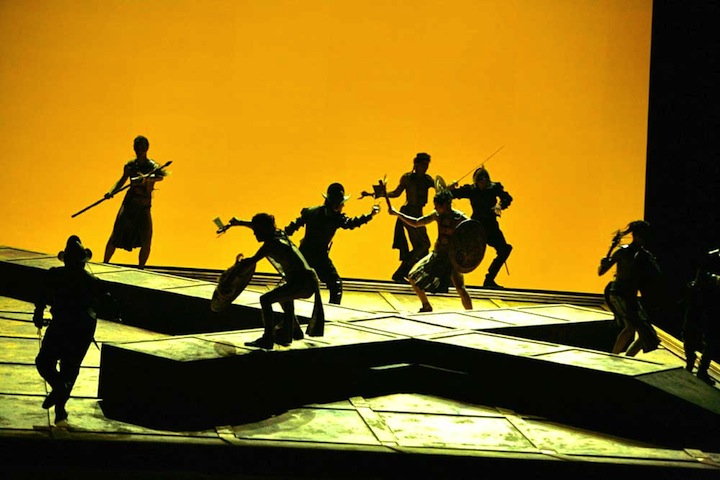
A month ahead of the annual Montreal Baroque Festival, Ensemble Caprice music director Matthias Maute has written a fascinating perspective on the period performance movement for Early Music America.
- Classical Music 101: What Does A Conductor Do? - June 17, 2019
- Classical Music 101 | What Does Period Instrument Mean? - May 6, 2019
- CLASSICAL MUSIC 101 | What Does It Mean To Be In Tune? - April 23, 2019
The magazine doesn’t take kindly to having its content reproduced elsewhere, and its website reveals little, so I need to condense Maute’s piercing observations about where the movement has come from and where it is going.
Maute’s essay is meant to get us particularly interested in this year’s Montreal Baroque festival, for which Maute has expanded and adapted the fragments we have of Antonio Vivaldi’s 1733 opera Montezuma — one of the few responses in European music to colonialism.
Maute has replaced Vivaldi’s recitative with dialogue in 21st century language, and the opera will be performed at the grand 1909 former headquarters of the Bank of Commerce in Old Montreal (details here).
It’s no coincidence that, next week, Toronto’s Against the Grain Theatre is presenting Figaro’s Wedding in a repurposed 19th century warehouse at Queen & Bathurst Sts — complete with contemporary dialogue instead of recitative (my article here, details here).
Just as new music composers are rediscovering tonality and traditional concert presenters are looking at alternative venues, historically informed performers are questioning what it means to present a relevant concert.
Does it mean sticking to the teaching of period-performance pioneers of the 1970s and ’80s? Some say yes. Others — especially the historically trained students of these modern masters — believe there are new ways to make the sounds of 1550 or 1725 sound exciting and relevant to a Torontonian or Montrealer, circa 2013.
As Maute writes in the Summer issue of Early Music America, “After all these years of research and practice, it is clear that there is no final ‘truth’ regarding performance practice. As with composition, where, if you start anywhere in history and jump ahead or backwards by a 30 years, you find a very different musical culture from where you started, so it is with early music performance.”
In his article, Maute asks questions that provoke. His answers come through his work as a working musician and as a composer and arranger.
“We do not necessarily share Bach’s certainty about his Protestant faith, and we don’t necessarily live in a world where God is all around us, like the air we breathe, as it was for the public who heard Bach’s great choral masterpieces for the first time,” writes Maute. “How much of the impact of the music is lost because of this? What do we need to do as performers to elicit from the audience the same degree of impact today? In doing so, do we have to step beyond the bounds of what we consider to be ‘authentic’? How does our knowledge of Schoenberg influence our understanding of Bach? How does the ubiquitousness of pop music in our lives influence how we expect the music of Vivaldi to sound? Would Bach attempt to re-create original conditions when he performed music by Machaut? The answer to that question is surely no. Does anyone still believe it’s even possible to do so today?”
“Perhaps it might be very helpful to ask some different questions,” Maute continues. “Could it be that our attempts at historical reconstruction, which at one level ultimately ring hollow, are still crucial? Perhaps it is only by the process of researching and imagining original conditions that we have the potential to create something that is truly of our own time?”
Yesterday, I wrote about how the 21st century pop concertgoer is used to create an immediate memento of the experience with their mobile device.
Today, Maute makes me think of all the great big-city restaurants where chefs freely borrow from various past and current cooking traditions to create something new and exciting. After dinner, there’s nothing wrong with mixing Bhangra in with the electro tracks at a dance club.
So why not try cultural fusion in art music?
Maute and Ensemble Caprice did this so beautifully on their last album, which alternated J.S. Bach’s Brandenburg Concertos with Op. 87 Preludes and Fugues by Dmitri Shostakovich — rearranged for his period ensemble. For me, the result was pure magic.
As with so much art music and opera, the secret to surprising and delighting an audience is not in following the rules, but in knowing them, honouring them — and then breaking them.
Or, as Maute writes so respectfully, “The future of early music must always involve more research, more study, and the desire to expand both our knowledge and our technique. It also requires us to remember that we are artists first, always seeking more open mindedness of what our human spirit can do. The first generation of historical performers rebelled against the destructive repetition of tradition, and going forward requires the same curiosity and love of experimentation today as then. Our field only exists because of the curiosity, the vision, and the love of music of its participants.”
(And their ability to convince an audience to go along for the ride.)
Here’s Ensemble Caprice’s promotional video for the Bach album, which features my favourite of Shostakovich’s Op. 87 Fugues:
John Terauds
- Classical Music 101: What Does A Conductor Do? - June 17, 2019
- Classical Music 101 | What Does Period Instrument Mean? - May 6, 2019
- CLASSICAL MUSIC 101 | What Does It Mean To Be In Tune? - April 23, 2019



